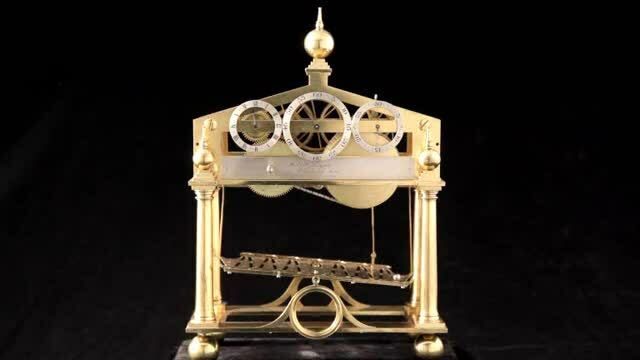Unlike the popular pendulum clocks of 200 years ago, the clock invented by William Congreve measures time through the movement of a small ball.
How the rolling ball clock works. (Video: Vimeo).
In the early 19th century, most clocks measured time through the regular oscillation of a pendulum. However, English inventor William Congreve (1772-1828) created an unusual clock that measures time using a small ball.
The Congreve rolling ball clock features a zigzag-engraved metal plate. A small brass ball rolls along the zigzag groove and the incline of the plate. At the end of the groove, the ball strikes a lever and a spring, causing this end of the metal plate to lift, reversing the incline and pushing the ball to roll back. The lever also moves the clock’s hand forward by an amount equal to the time the ball rolled along the groove. In most versions, this interval is 15 seconds, but in some larger clocks, it can be as long as one minute.
Although Congreve is often credited as the inventor of the rolling ball clock, his design was not the first. French inventor Nicolas Grollier de Servière and German clockmaker Johann Sayller created similar clocks in the 17th century.

Rolling ball clock.
Some believe that Congreve was unaware of these earlier designs, but according to Mark Frank, who runs a website about antique clocks, Congreve may have borrowed some details from Johann Sayller’s clock, especially since both designs use a zigzag path (Grollier’s rolling ball clock used a straight line). A notable difference is that Sayller’s design utilized multiple balls and a fixed flat plate instead of one ball and an inclined plate as Congreve did.
The accuracy of the rolling ball clock is easily affected by external factors. Setting up the clock requires extreme precision. In 1837, the staff responsible for timing with the rolling ball clock at Buckingham Palace described it as the most complex and troublesome machine.
Darren Cox, a technology conservator at the National Museum of Scotland, struggled with one of these clocks for two months. “The clock and the inclined plate (front and back) need to be perfectly balanced. I found that even with a temporary cover I made to keep out dust, the metal ball still needed to be polished at least every two weeks to remove debris,” he explained.
“However, the biggest task for the clock to function is adjusting every lever and the previously warped and twisted flat plate. Just a slight error can cause the ball to stop rolling, and if it doesn’t roll fast enough, it won’t trigger the reaction chain and lift the inclined plate,” he added.
Dust is also a significant issue. The time it takes for the ball to roll down the incline varies greatly depending on the cleanliness of the groove and the ball. Additionally, metal expands or contracts with temperature changes, altering the length of the groove and the size of the ball. Darren Cox noted that the rolling ball clock could deviate by as much as 45 minutes a day. However, even though they are not reliable timekeeping tools, they are visually striking and operate in an intriguing way, captivating observers.


















































